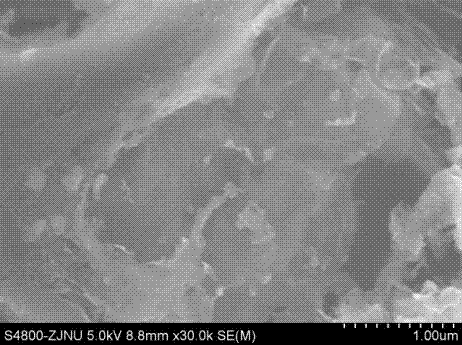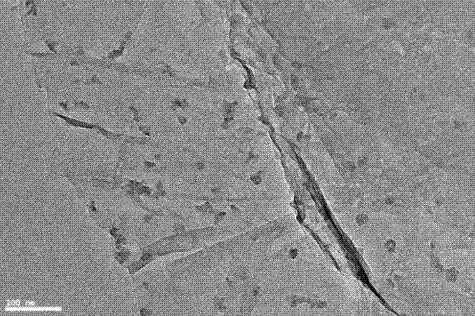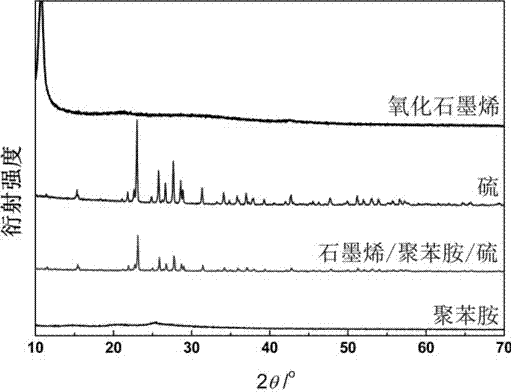Graphene/polyaniline/sulfur composite material and preparation method thereof
A composite material and graphene technology, applied in electrical components, electrochemical generators, battery electrodes, etc., can solve the problems of low sulfur utilization rate and low capacity, and achieve the effects of environmental friendliness, high capacity, and alleviation of volume expansion.
- Summary
- Abstract
- Description
- Claims
- Application Information
AI Technical Summary
Problems solved by technology
Method used
Image
Examples
Embodiment 1
[0028] A kind of with graphene oxide, aniline, hydrochloric acid, sodium thiosulfate, water is the concrete steps of raw material preparation graphene / polyaniline / sulfur composite material as follows:
[0029] (1) Take 0.1 g graphene oxide and disperse it in 100 g water to form a uniform graphene oxide solution;
[0030] (2) Take 0.1 g of aniline and dissolve it in 1.825 g of hydrochloric acid (35% concentration) to form an aniline salt solution, and add it to the graphene oxide solution in step (1);
[0031] (3) Weigh 6.2 g of sodium thiosulfate solid and dissolve it in 20 g of water to form a sodium thiosulfate solution, which is gradually added dropwise to the mixed solution in step (2) and stirred at room temperature at 70°C for 24 h;
[0032] (4) The dark green precipitate obtained in step (3) is separated, washed, and dried to obtain a graphene / polyaniline / sulfur composite material, and its scanning electron microscope (SEM) photo is shown in figure 1 , whose transmissi...
Embodiment 2
[0036] A kind of with graphene oxide, aniline, hydrochloric acid, sodium thiosulfate, water is the concrete steps of raw material preparation graphene / polyaniline / sulfur composite material as follows:
[0037] (1) Take 1 g of graphene oxide and disperse it in 100 g of water to form a uniform graphene oxide solution;
[0038] (2) Take 0.1 g of aniline and dissolve it in 1.825 g of hydrochloric acid (35% concentration) to form an aniline salt solution, and add it to the graphene oxide solution in step (1);
[0039] (3) Weigh 6.2 g of sodium thiosulfate solid and dissolve it in 20 g of water to form a sodium thiosulfate solution, which is gradually added dropwise to the mixed solution in step (2), and stirred at 70° C. for 24 h;
[0040] (4) The dark green precipitation obtained in step (3) is separated, washed, and dried to obtain a graphene / polyaniline / sulfur composite material, its scanning electron microscope (SEM) photo and transmission electron microscope (TEM) photo and em...
Embodiment 3
[0042] A kind of with graphene oxide, aniline, hydrochloric acid, sodium thiosulfate, water is the concrete steps of raw material preparation graphene / polyaniline / sulfur composite material as follows:
[0043](1) Take 0.1 g graphene oxide and disperse it in 100 g water to form a uniform graphene oxide solution;
[0044] (2) Measure 1 g of aniline and dissolve it in 1.825 g of hydrochloric acid (concentration is 35%) to form an aniline salt solution, and add it to the graphene oxide solution in step (1);
[0045] (3) Weigh 6.2 g of sodium thiosulfate solid and dissolve it in 20 g of water to form a sodium thiosulfate solution, which is gradually added dropwise to the mixed solution in step (2), and stirred at 70° C. for 24 h;
[0046] (4) The dark green precipitation obtained in step (3) is separated, washed, and dried to obtain a graphene / polyaniline / sulfur composite material, its scanning electron microscope (SEM) photo and transmission electron microscope (TEM) photo and emb...
PUM
| Property | Measurement | Unit |
|---|---|---|
| Discharge specific capacity | aaaaa | aaaaa |
Abstract
Description
Claims
Application Information
 Login to View More
Login to View More - R&D
- Intellectual Property
- Life Sciences
- Materials
- Tech Scout
- Unparalleled Data Quality
- Higher Quality Content
- 60% Fewer Hallucinations
Browse by: Latest US Patents, China's latest patents, Technical Efficacy Thesaurus, Application Domain, Technology Topic, Popular Technical Reports.
© 2025 PatSnap. All rights reserved.Legal|Privacy policy|Modern Slavery Act Transparency Statement|Sitemap|About US| Contact US: help@patsnap.com



